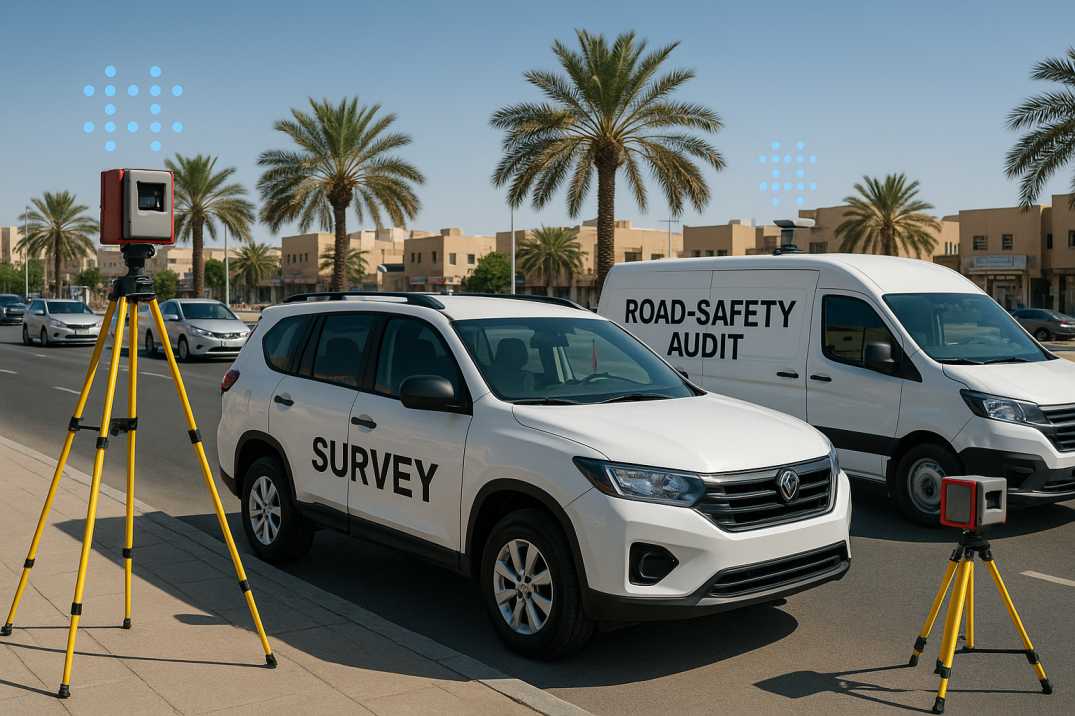Contact Us
RoadVision AI
Private Limited
Office No. 308 & 310, B Block
Ansal Chamber - 1, Bhikaji Cama Place,
Near Engineers India Limited (EIL) Bhawan, New Delhi - 110066
© 2024 | RoadVision AI | All rights reserved
Saudi Arabia is rapidly transforming its infrastructure under Vision 2030, prioritizing modern networks, enhanced safety, and smart mobility Saudi Arabia. A critical enabler of this transformation is adopting digital traffic monitoring and AI traffic survey systems that support efficient road asset management Saudi Arabia.

Vision 2030 emphasizes sustainable, safe, and connected transport infrastructure. Saudi Arabia’s General Authority for Roads (RGA) launched the Saudi Road Code with 25 regulations covering planning, design, operation and maintenance—including autonomous vehicles and safety metrics—all aligned to reduce road fatalities to below five per 100,000 by 2030.
The Saudi Data and AI Authority (SDAIA) has deployed systems like Sawaher and Smart C, using AI and computer vision to analyze traffic in real time at both citywide and street‑level scales. These platforms enable predictive insights—identifying accident hotspots, optimizing signal timing, and anticipating seasonal flows such as Ramadan shifts.
SHC 603 – part of Saudi Arabia’s highway code – mandates systematic collection of traffic volume, road class, junction geometry, ADT/AADT and crash data for meaningful road audits and forecasts. Digital traffic surveys allow continuous, accurate assessment of infrastructure, essential for effective smart mobility Saudi Arabia strategies.
Systems like Saher, the automated traffic enforcement camera network, monitor speeding, seat‑belt usage, and mobile phone violations across major cities, enabling swift enforcement and improved road safety outcomes.
Ministry of Transport reports a 40 % reduction in road maintenance time due to advanced technologies and digital asset surveys, simultaneously lowering carbon emissions and improving user experience.
AI systems respond instantly to congestion, adjust signal timings, and reroute flows, reducing delays by up to 20–25 % based on pilot deployments in Riyadh and Jeddah. This supports traffic flow management aligned with Vision 2030’s smart city goals.
Predictive analytics based on real‑time and historical traffic data empower planners to design safer intersections, optimize road capacity, and anticipate demand shifts—supporting sustainable expansion of highways, metros, and mega‑projects like NEOM.
Using digital surveys and crash data from SHC 603, authorities can conduct proactive road safety audit programs to inform infrastructure improvements, signage upgrades, and enforcement priorities.
RoadVision AI offers solutions across traffic survey, road inventory inspection, pavement condition survey, and road safety audit. By deploying its digital traffic monitoring platform, Saudi municipalities can:
Saudi Arabia’s major road projects—from Riyadh’s $3.5 billion ring road upgrades to metro extensions—will significantly increase traffic volumes and connectivity. Only with robust digital traffic survey Saudi systems can planners ensure these investments align with Vision 2030 objectives and meet demands for smart mobility Saudi Arabia.
Saudi Arabia’s roadmap under Vision 2030 includes ambitious goals for safety, sustainability, and mobility. Digital traffic surveys, AI traffic flow management, and AI traffic monitoring are not optional—they are vital tools for road asset management Saudi Arabia, data‑driven planning, and safer, smarter infrastructure. By integrating these technologies, Saudi roads can evolve into efficient, predictive networks aligned with national strategic objectives.
RoadVision AI is transforming infrastructure development and maintenance by harnessing AI in roads to enhance safety and streamline road management. Using advanced roads AI technology, the platform enables early detection of potholes, cracks, and surface defects through precise pavement surveys, ensuring timely maintenance and optimal road conditions. Committed to building smarter, safer, and more sustainable roads, RoadVision AI aligns with IRC Codes, aligns with SHC 101 and SHC 202 — Saudi Arabia’s official highway and infrastructure development codes, empowering engineers and stakeholders with data-driven insights that cut costs, reduce risks, and enhance the overall transportation experience.
Book a demo with us.
Q1. What is a digital traffic survey and how does it differ from manual surveys?
A digital traffic survey uses sensors, cameras, and AI tools to automatically collect traffic flow, volume, and classification data in real time. Manual surveys rely on human operators and take longer, with more errors.
Q2. How does AI traffic monitoring improve road safety in Saudi Arabia?
AI monitors violation patterns, accident hotspots, and peak traffic flows, enabling targeted interventions such as signage upgrades or signal optimization, aligned with SHC 603 safety audit frameworks.
Q3. Can digital traffic data help Vision 2030 road planning?
Yes. Accurate ADT/AADT volumes, vehicle classification and temporal patterns help planners allocate road resources efficiently, forecast demand growth, and support mega‑projects with smart mobility integration.